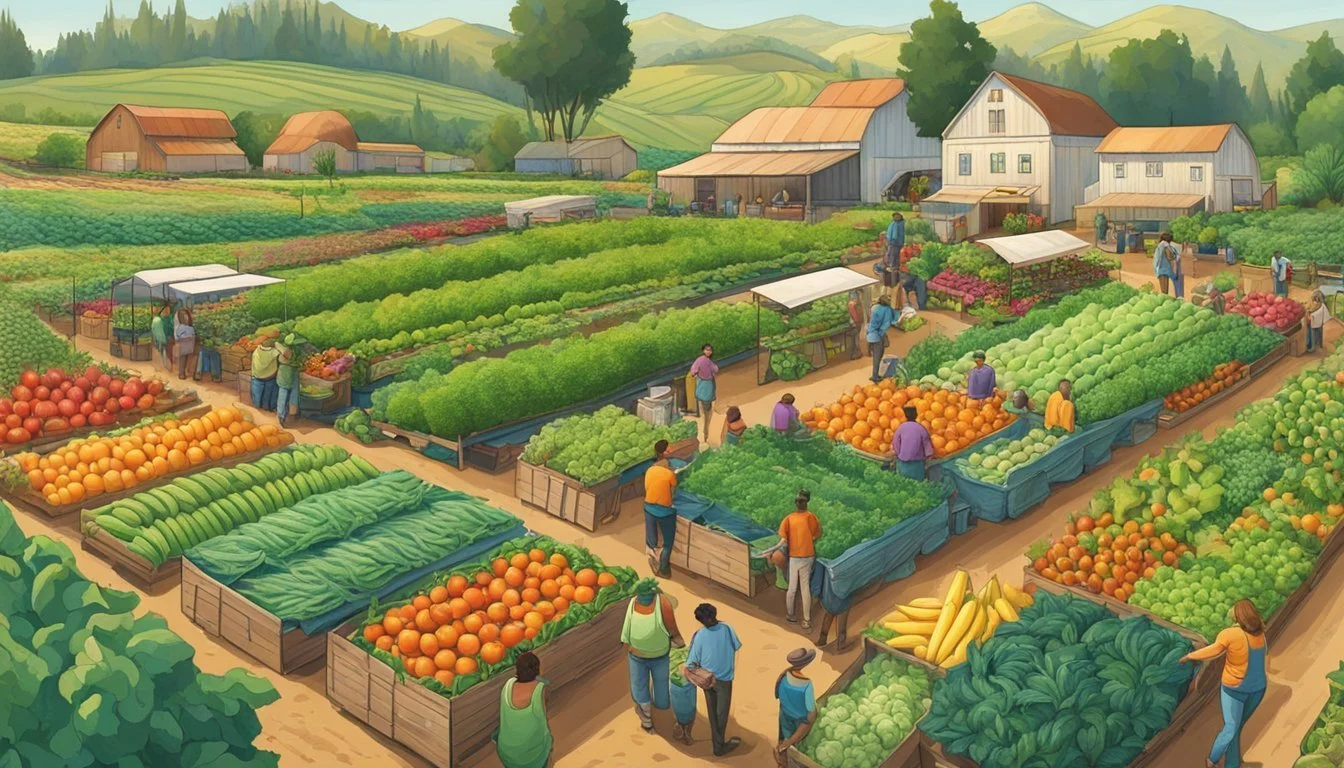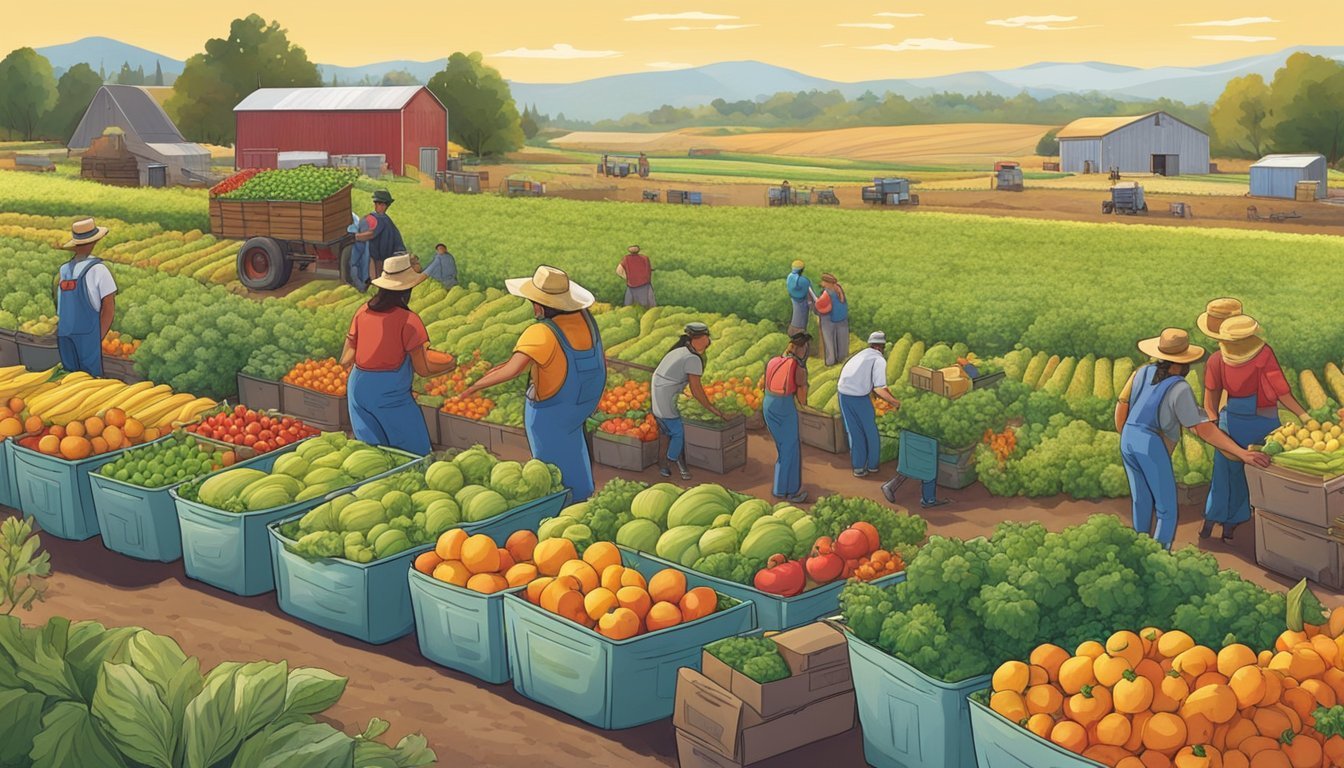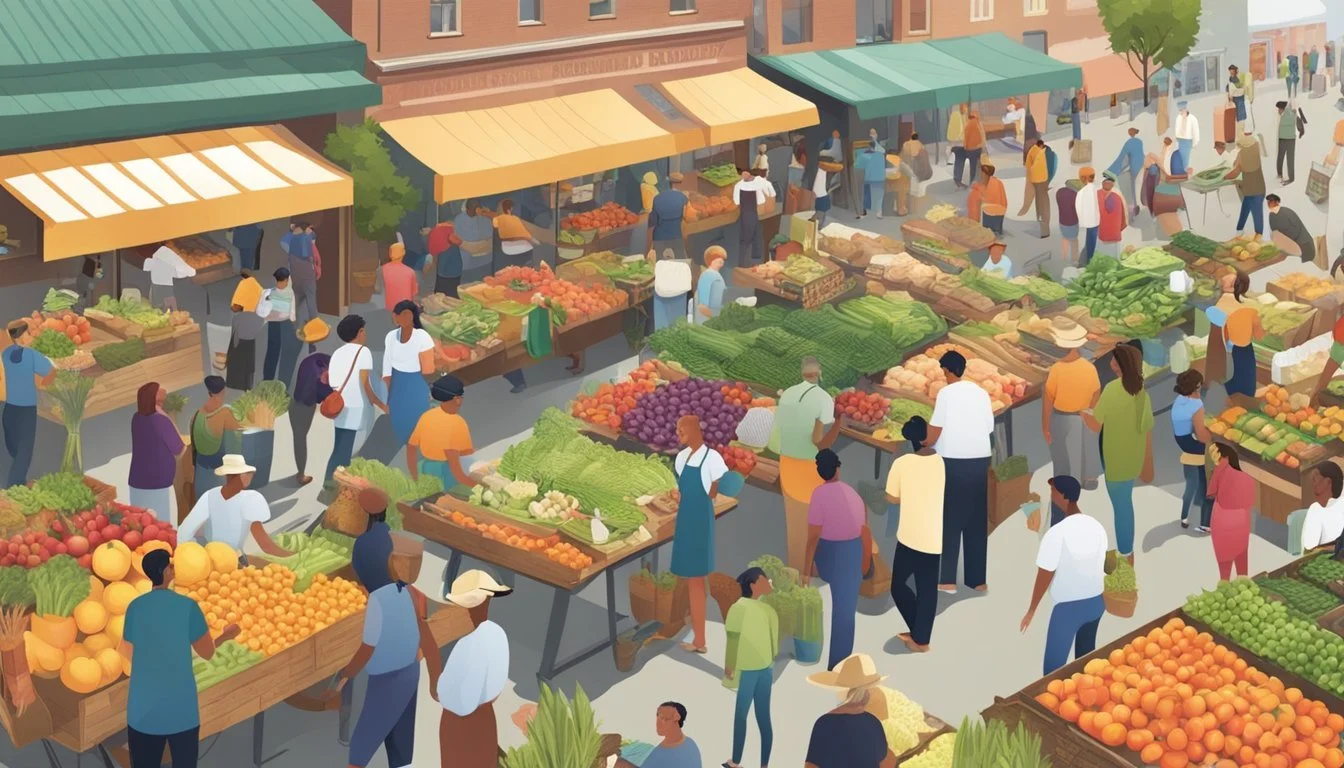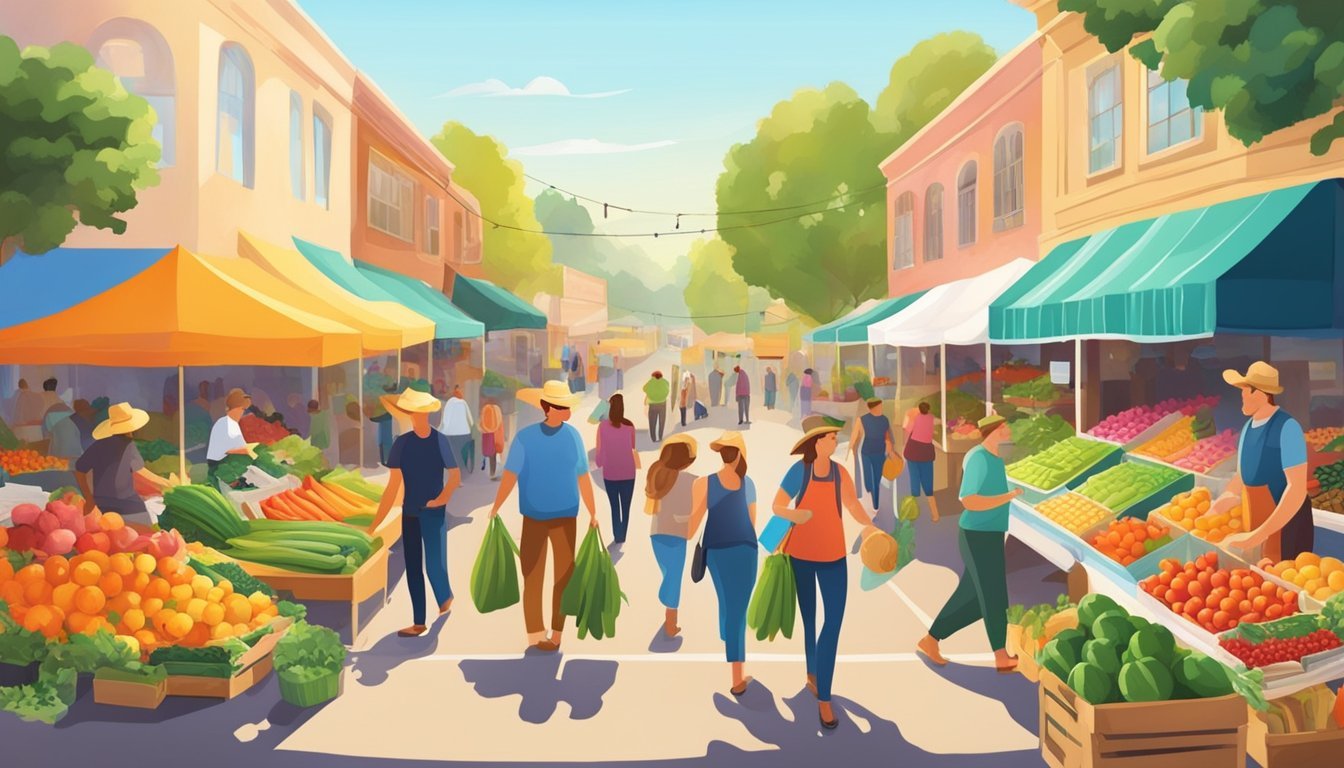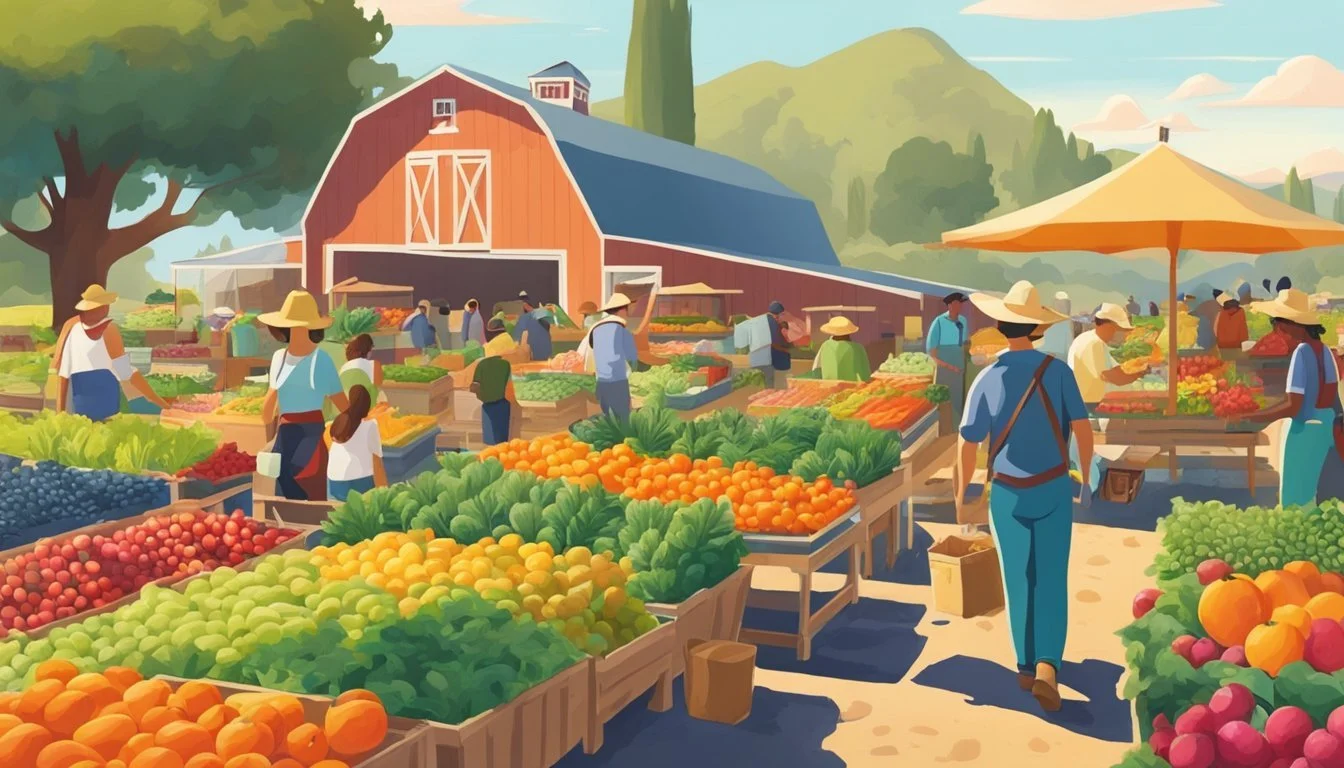Community Supported Agriculture (CSA) in California
Benefits and Growth Trends
Community Supported Agriculture (CSA) represents a model where consumers buy seasonal food directly from local farmers in California. This approach to agriculture is structured around the sale of shares to consumers, who are often referred to as members. These shares typically consist of a box of produce and possibly other farm products. In return for their investment, members receive regular deliveries of fresh, locally grown goods during the farming season. CSA is more than a simple exchange of produce for payment; it forges a relationship where the risk and rewards of farming are shared, and consumers become active participants in the support and success of local agriculture.
In California, the CSA model has gained traction as it aligns with the state's strong focus on sustainable living and community. The model provides an alternative to the industrial food system's often criticized practices by promoting local, environmentally responsible agriculture. By directly linking producers with consumers, CSA in California aims to enhance the economic viability of small farms while ensuring that communities have access to fresh, nutritious food. This aligns closely with California's broader goals of fostering sustainable farming practices and supporting the resilience of local food systems.
The significance of CSA in California is also reflected through targeted research and comprehensive accounts of its social and economic impacts. Studies based out of organizations and universities within the state indicate a persistent endeavor to understand and evolve the CSA framework. This research often focuses on the characteristics of CSA farms, their operators, and memberships, providing valuable insights into the successful implementation of the model. Such efforts underscore the state's commitment to supporting and advancing community-based agriculture.
History of CSA in California
Community Supported Agriculture has a significant presence in California, marked by a rich history of development and a substantial contribution to the state's agriculture landscape. From its humble beginnings, CSA in California has matured into a movement supporting local agriculture and fostering community relationships.
Origins of Community Supported Agriculture
The concept of Community Supported Agriculture (CSA) can trace its history back several decades. While the wider CSA movement began in the United States during the 1980s, California quickly became a fertile ground for this innovative agricultural model, embracing the concept due to the state's year-round growing season and focus on sustainable agriculture practices. The state’s residents have historically been receptive to initiatives that promote health, the environment, and local economies, making CSA a natural fit.
Growth and Development
The evolution of CSA in California saw a surge in the number of farms adopting this model. Fueled by consumers' growing preferences for local and organic produce, CSA programs have proliferated throughout the state. Farms in California have used CSA to market their produce directly to consumers, which in turn has helped bolster the state's small farm economy against the challenges faced in the wider industrial food system. Californian CSAs have diversified in offerings, including fruits, vegetables, and even artisan products, reflecting the demand for a wider variety of locally-sourced goods.
This movement has not only connected consumers with the source of their food but has also fostered a sense of community and shared responsibility for the success of local farms. The adaptability and resilience of CSA in California have proven vital in its growth, allowing the state to become a notable leader in the national CSA landscape.
Understanding CSA
Community Supported Agriculture, or CSA, represents a method where consumers buy shares in a farm's production and in turn receive a portion of the produce throughout the farming season. This exchange not only provides fresh local produce to members but also supports the farm's financial stability.
CSA Model Explained
The CSA model is a partnership between a farmer and individuals who become members or subscribers. Members pay in advance for a share of the farm's output, which helps cover the initial production costs. This model allows for mutual support as members share in the risks and benefits of food production. In California, the CSA model contributes to a sustainable agricultural community, emphasizing close consumer-producer relationships and a commitment to ecologically responsible farming practices.
Typical CSA Farm Structure
CSA farms typically operate on a smaller scale compared to industrial farms, focusing on diverse crops suitable for local conditions. Farmers often practice sustainable methods, such as organic farming, to ensure healthy and environmentally friendly produce. These farms serve as integral parts of the community, fostering connectivity between people and the food they consume. Regular harvest updates and farm visit opportunities are common, underlining the transparent relationship between the CSA farm and its members.
Membership and Share Systems
Members of a CSA commit upfront, purchasing a "share" of the farm. This commitment entitles them to a weekly or bi-weekly delivery of seasonal produce, which can vary in quantity and type depending on farm production and time of year.
Share types:
Full share: Suitable for families or individuals with high vegetable consumption.
Partial share: Ideal for smaller households or those new to CSA.
The system strengthens the tie between the farm's success and its community, ensuring that members have a vested interest in supporting local agriculture. Members often appreciate this connection, as it offers transparency and a sense of contribution to local food systems.
Benefits of CSA
Community Supported Agriculture (CSA) presents distinct advantages by forging a synergistic relationship between consumers, farmers, and local food systems, thereby promoting health and community resilience.
For Consumers
Consumers benefit directly from CSAs through access to fresh, seasonal produce that is often organically grown. By investing in a CSA share:
They receive a variety of locally grown foods.
They are exposed to new vegetables and ways of cooking.
Health is bolstered by nutrient-rich offerings.
The relationship with the farmer fosters a deeper understanding of the food system.
For Farmers
Farmers participating in a CSA model experience several advantages:
Predictable income from pre-season payments improves financial stability.
Direct consumer feedback helps in responsive planning and community engagement.
Risk is shared with consumers, which can alleviate some pressures of farming.
For Local Food Systems
Local food systems are strengthened by CSAs for the following reasons:
They increase consumer investment in local agriculture.
Small-scale operations find support, enhancing food diversity.
They reduce the carbon footprint through minimized transport, contributing to a healthier environment.
Challenges in CSA
In California's CSA models, critical issues like retaining members, ensuring consistent production, and navigating market competition are vital for sustainable operations.
Member Retention
CSA farms in California face the challenge of keeping their members engaged over time. High turnover rates have been observed, requiring constant outreach and innovative strategies to maintain a stable member base. Specifically, the retention of former CSA members is a concern, indicating the necessity for improved communication on the value and benefits of continued membership.
Production Consistency
Consistent production is a cornerstone of CSA success, yet California's CSA farms must contend with fluctuating demand and climatic challenges that can compromise crop yields. They must balance member expectations with the unpredictability of agriculture, a task requiring adept planning and management.
Market Competition
CSA operators are often small-scale producers who must compete in a market populated by larger, more established entities. Effective direct marketing strategies are crucial to distinguish their offerings. Nonetheless, the saturation of alternative food networks can dilute their market presence, making it more difficult to attract and retain CSA members amidst ample choices.
These subsections represent a selection of the multifaceted hurdles CSAs contend with, each interwoven with the viability and durability of the CSA model within Californian agriculture.
Economic Aspects
Community Supported Agriculture (CSA) in California mobilizes local funding and resources to enhance its economic sustainability. It plays a pivotal role as an alternative food network that significantly affects the state's agricultural economy.
Funding and Resources
To establish and run a successful CSA in California, there is a reliance on a variety of funding options. These include member subscriptions, where consumers pay in advance for a season's worth of agricultural products, providing critical upfront capital for farmers. Additionally, grants and loans, particularly those aimed at sustainable agriculture, also contribute crucial resources. Effective management of these funds is paramount for the continuity of CSA farms.
Key Funding Sources:
Member subscriptions/prepayments
Sustainable agriculture grants
Agricultural loans
Economic Sustainability
Economic sustainability within CSAs is found through a model that directly connects farmers with consumers. This circumvents traditional retail markup and reduces transportation costs. A survey of 111 CSA farms found that the management variables influencing sustainability include product pricing, distribution methods, and member engagement. Retention of CSA members is also critical for sustained cash flow and operational success.
Sustainable Practices Include:
Fair pricing strategies
Efficient distribution systems
Strong member-farmer relationships
Alternative Food Networks
CSAs are at the core of California's alternative food networks, offering an innovative channel that contrasts with the industrial food system. They provide local, often organic produce, bridging the gap between low-income households and access to healthy foods. Research indicates that by integrating into the broader community and prioritizing education on the importance of sustainable agriculture, CSAs can extend their impact on the local food economy.
CSA Impact on Alternative Food Networks:
Connecting low-income communities with quality produce
Educational programs to raise awareness
Strengthening local food economies
Legal and Regulatory Framework
In California, CSA programs fall under specific legal and regulatory frameworks that govern agricultural policy and food safety. These frameworks are instrumental in ensuring that CSA programs operate effectively within the state, adhering to standards that protect both consumers and producers.
Agricultural Policy and CSA
Under California law, Community-supported agriculture (CSA) programs must register with the California Department of Food and Agriculture (CDFA). The CDFA mandates that both single-farm and multi-farm CSAs be farm-based and renew their registration annually. AB 224, enacted in 2013, is a key piece of legislation that outlines these requirements.
Registration Requirement: All CSAs in California must register with the CDFA.
Annual Fee: CSAs are required to pay an annual registration fee; currently, this is set at $75 per farm involved.
These regulations ensure a structured approach to CSA operations, providing a viable economic model for local producers and clear guidelines for consumer participation.
Food Safety Regulations
Food safety in CSA programs is of utmost importance, and California enforces rigorous standards to safeguard public health. CSAs must comply with state and federal regulations, including those set forth by the U.S. Department of Agriculture (USDA), to operate within the state. The application of these regulations ensures that produce from CSAs meets the same safety standards as produce sold through other traditional outlets.
Health and Safety Codes: CSAs adhere to California's comprehensive health and safety codes.
USDA Guidance: Provides additional food safety guidelines for CSA operations.
Programs such as CalFresh, EBT, SNAP, and WIC offer means for lower-income individuals to access fresh produce from CSAs, reflecting a commitment to community health and support for local agriculture. Compliance with food safety regulations is a critical component that enhances consumer confidence in CSA products.
Marketing and Outreach
Successful marketing and outreach strategies are essential for Community Supported Agriculture (CSA) programs in California to thrive. They rely heavily on building robust direct marketing channels, engaging the community effectively, and utilizing digital platforms to reach potential members.
Direct Marketing Strategies
Direct marketing for CSA involves personal connections between farmers and consumers. California producers often use farmers markets and farm stands as platforms to interact with local communities, educate them about the CSA model, and sell shares of their future harvests. They also navigate through intricate laws and regulations unique to California's direct marketing scene.
Community Engagement
Community engagement is at the heart of CSA in California. Farmers foster close relationships with their members, who effectively become stakeholders in the agricultural process. This direct involvement encourages transparency and builds trust, which can be a compelling marketing tool. Membership discussions, often facilitated in community gatherings or even through Facebook groups, are common practices for engagement.
Digital Marketing and Social Media
Digital marketing and social media are powerful tools for expanding a CSA's reach. A well-maintained online presence, from informative websites to active social media profiles, can attract a diverse member base. Online communication strategies, including email newsletters and social media posts, inform potential subscribers about sign-up deadlines, community events, and available CSA shares.
Demographics and Sociocultural Impact
This section addresses the diverse membership of Community Supported Agriculture in California and its influence on the surrounding community’s culture and economy.
Diversity and Inclusivity
In California, Community Supported Agriculture (CSA) programs have become a reflection of the state's wide-ranging demographics. Efforts to connect low-income households to CSA networks demonstrate a commitment to inclusivity. The diversity of products offered by CSAs plays into this by appealing to various cultural preferences and dietary requirements, thereby attracting a broader membership base.
Challenges: Maintaining affordability and accessibility for all income levels.
Strategies: Various CSAs employ sliding scale pricing, accept food assistance programs, and provide community outreach.
The Moral Economy of CSA
The moral economy of CSA stems from values-driven transactions that extend beyond mere profit. CSA members often share a commitment to ethical food production, including support for sustainable and organic farming. This moral economy fosters a sense of responsibility and ethical considerations among both producers and consumers.
Key Values: Sustainability, fair labor practices, local economic support.
Consumer Connection: Through subscription fees, members invest in the farm's success and its ethical food production practices.
Social Impact and Community Building
CSAs in California contribute significantly to community building. The direct interaction between farmers and community members engenders a stronger sense of community, which is a marked contrast to the anonymity of traditional supermarket transactions.
Community Events: Farm visits, potlucks, and workshops that engage members.
Collaboration: Sharing of resources and knowledge between community members and farmers.
By intertwining the economic exchange with social values and community interaction, CSAs in California nurture a cohesive community around food that supports diversity, inclusivity, and a moral economy.
Operational Management of CSA Farms
Efficient operational management is pivotal to the success of Community Supported Agriculture (CSA) farms in California. It encompasses best practices in administration, handling of labor and volunteers, and prioritizing member experiences, which are integral components of maintaining a robust CSA system.
CSA Management Best Practices
CSA management must maintain consistent, quality produce deliveries and an open line of communication with members. Farms often implement a technology-based system for tracking memberships and managing distribution logistics. Effective financial management strategies including budgeting, price-setting, and investment in sustainable farming practices aid in long-term viability.
Membership Tracking: Use software for real-time member subscription management.
Financial Planning: Annual budget plans and clear pricing structures.
Sustainable Practices: Invest in organic or biodynamic farming methods.
Volunteer and Labor Management
CSAs rely on labor for various farm activities, which might include both paid staff and volunteers. It's critical to establish a clear division of labor and to ensure that all staff are properly trained and acquainted with safety protocols.
Labor Division: Assign roles based on skills and farm needs.
Training: Regular, comprehensive training sessions.
Safety: Implement and enforce safety standards.
Member Experiences and Feedback
Positive member experiences promote retention and are a cornerstone of CSA operations. Regular feedback collection and member engagement events are strategies farms utilize to maintain good relationships with their members.
Feedback Mechanisms: Online surveys and suggestion boxes.
Engagement: Host farm visits and community events.
Communication: Weekly newsletters with farm updates and box contents.
Special Topics in CSA Practice
Community Supported Agriculture in California continuously evolves, incorporating innovative practices that both challenge and enhance its operations. The following subsections detail specific areas of interest within CSA practices: the customization paradox, the use of critical cartography and GIS, and the impact of technological advancements.
Customization Paradox
CSAs traditionally provide a set selection of farm products to their members, but with the rise of customization options, the essence of community support is at a crossroads. The customization paradox arises from the tension between member preferences and the inherent risk-sharing principle of CSAs. On one hand, customization can lead to increased member satisfaction and retention. On the other, it might dilute the community-centric model that expects members to share in the seasonal variations and potential produce unpredictability.
Critical Cartography and GIS in CSA
Critical cartography and Geographic Information Systems (GIS) are reshaping how CSAs understand their members and land. By adopting critical cartography and GIS, farmers and consumers can visualize and analyze various aspects, such as distribution routes, member demographics, and land use patterns. This spatial analysis helps in designing more efficient delivery routes, identifying potential markets, and in some cases, assessing the environmental impact of the CSA operations.
Technological Innovations in CSA
Innovations in technology have provided CSAs with tools to streamline operations and improve member experiences. Technological innovations range from farm management software to mobile applications that facilitate order customization and real-time communication between farmers and consumers. Data collected through these platforms can lead to better crop planning, more accurate yield forecasts, and enhanced understanding of consumer trends, ultimately contributing to the economic and ecological sustainability of CSAs.
CSA in Different Regions of California
Community Supported Agriculture (CSA) in California showcases unique offerings and practices across various regions, each influenced by local conditions and community profiles.
Northern California CSA Farms
In Northern California, CSA farms serve a diverse array of communities ranging from the bustling tech hubs of the Bay Area to the more rural expanses of the North Coast. These farms often provide a wide range of organic produce, tapping into the local demand for sustainably farmed goods. An example of this regional specificity is found in Sacramento's fair-share programs, which are tailored to support both CSA farmers and subscribers through equitable distribution of the harvest.
Southern California CSA Enterprises
Southern California's CSA enterprises cater to the health-conscious lifestyles prevalent in the region. The CSA model here adapts not only to the dense urban environments of Los Angeles and San Diego but also to the agricultural strongholds such as Ventura County. These enterprises frequently engage with national CSA community of practice, exchanging knowledge to enhance both the quality and reach of their services.
Coastal and Central Valley CSA Variations
Along the coast and throughout California's Central Valley, CSA variations exist in response to the different microclimates and soil types characterizing these areas. Coastal CSAs often offer an array of specialty crops like heirloom varieties and niche items that thrive in the mild coastal climate, while Central Valley operations, nestled in one of the nation's most productive agricultural areas, provide a significant quantity of staple crops to both local and distant subscribers.
Future of CSA in California
As California's agriculture sector embraces innovation, the future of Community Supported Agriculture (CSA) is shaped by emerging trends, educational efforts, and the drive for sustainability in response to climate change.
Trends and Future Directions
In California, the CSA model is experiencing a positive trajectory, with increasing consumer interest in local, sustainable food sources. One can observe a growth in CSA programs, particularly those offering diverse and organic produce. As a result, there is a rising demand for CSAs which directly connect consumers with local farms, promoting economic viability for small-scale producers. With technological advancements, CSA programs have the potential to leverage online platforms to improve distribution efficiency and member engagement, further enhancing the economic sustainability of these local food systems.
Research and Educational Opportunities
Research plays a pivotal role in the advancement of CSAs. California's educational institutions have a unique opportunity to analyze CSA attributes and their impacts on both consumers and producers. Studies focusing on the social and economic characteristics of CSA farms provide invaluable data that can be used to improve CSA management practices. Further, the integration of CSA topics in agricultural education programs can equip new farmers with the knowledge and tools necessary to operate successful CSAs, thereby fostering innovation and ensuring the continuity of the CSA model within the state's evolving food system.
Sustainability and Climate Resilience
The synergy between CSA attributes and sustainability is clear, with CSA programs often prioritizing organic and regenerative farming practices that contribute to climate resilience. Climate change poses a significant threat to agriculture, but CSAs in California are poised to respond effectively due to their inherent flexibility and community support structures. Research that evaluates the resilience of CSA models in the face of climatic challenges can guide future CSA practices to further mitigate the impacts of global warming on local food systems. By adopting environmentally friendly practices and focusing on local distribution, CSA programs are key players in California's pursuit of a more sustainable and resilient agricultural landscape.
Additional Resources
The following resources are comprehensive for those seeking to deepen their knowledge or actively participate in California's Community Supported Agriculture (CSA) framework.
Educational Materials and Workshops
California's CSA stakeholders have access to a wealth of educational materials and workshops. Notably, the University of California, Davis, often facilitates a range of workshops tailored to CSA farmers and members. These workshops often cover best practices, new agricultural techniques, and sustainability. Resources can also be found on eScholarship, with extensive research papers and articles specific to California's CSA scene.
UC Davis Extension: Offers courses on sustainable agriculture and farm management.
eScholarship: Provides access to academic research and publications on CSA.
Online Forums and Networks
For CSA members and farmers seeking to exchange information, online forums and networks provide platforms for discussion and engagement. Questions and answers, success stories, and challenges are commonly shared, creating a virtual support system.
California CSA Network: Facilitates online discussions and exchanges between farmers and consumers.
Local Harvest: An online directory and forum for finding and discussing CSAs.
California CSA Organizations and Contacts
Numerous organizations operate within California, serving as vital contacts for Community Supported Agriculture initiatives. They can provide detailed information, including CSA locations, subscription details, and more.
Community Alliance with Family Farmers (CAFF): Offers support and resources to family farmers and consumers interested in CSA.
California Department of Food and Agriculture (CDFA): Lists registered CSA programs and provides regulatory information.
By utilizing these resources, individuals can engage with CSA in California at a deeper level, contributing to the agriculture community's vitality and sustainability.
Appendix
This appendix serves as a resource to further understand Community Supported Agriculture (CSA) in California through a glossary of relevant terms and answers to frequently asked questions.
Glossary of CSA Terms
CSA (Community Supported Agriculture): A model where individuals buy "shares" of a farm's harvest in advance, primarily functioning to form a community around local agriculture.
Share: Refers to the portion of the farm’s production allocated to members during the CSA season.
Member: An individual or household that subscribes to the CSA by purchasing a share.
Season: The duration for which CSA members receive produce, typically coinciding with regional growing seasons.
Frequently Asked Questions
What is a CSA membership?
A CSA membership entails an upfront investment in a local farm, in exchange for a regular allotment of produce throughout the farming season.
How do I join a CSA in California?
Find a local CSA program, then commit to purchasing a share for the season. This typically involves signing a contract and paying a fee upfront.
What do CSA shares typically include?
Shares usually consist of a variety of fresh produce, with the selection changing seasonally. Some CSAs also offer options like eggs, meat, or dairy.
Do members have a say in what is grown?
While the farmer generally decides the crops, some CSAs offer customization options or members can give feedback that may influence future crop selections.




